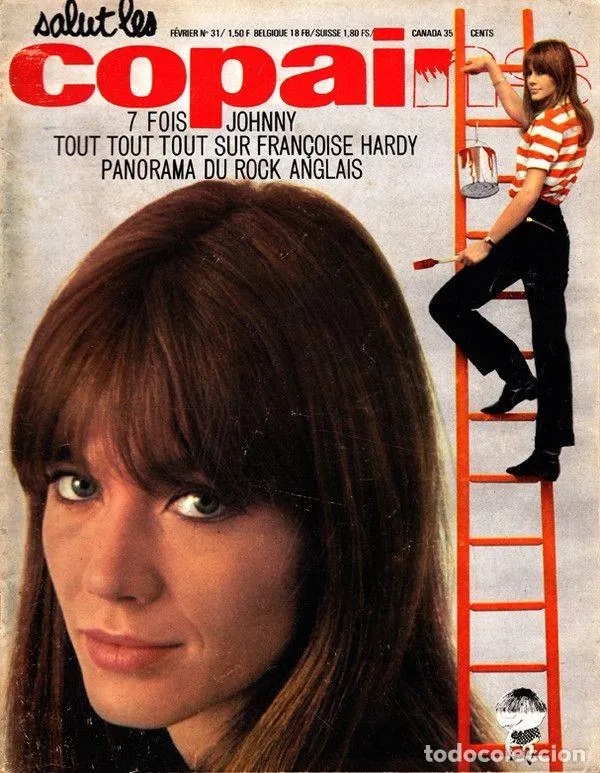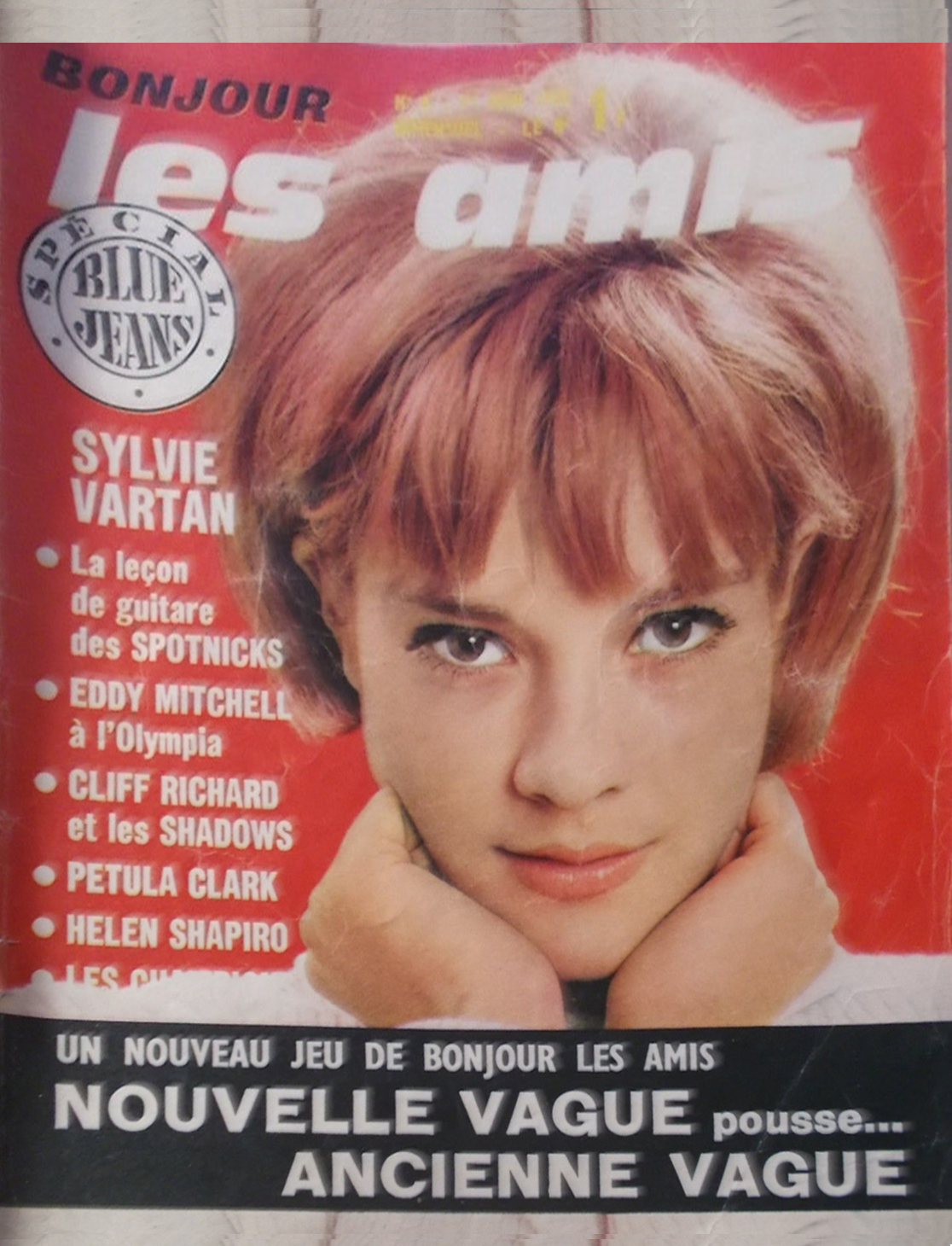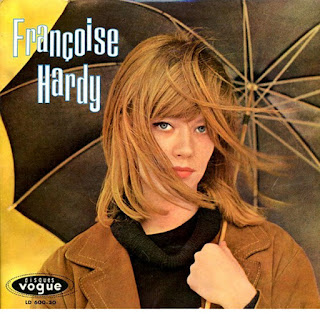The French charts... a strange and murky place (part one: 1955-1963)
To begin with, there was no official French chart until November 1984, when the top 50 was published for the first time. This was a sales chart and seems to have been accepted as accurate from the start, although like most other country's charts at the time, it would have been based on sales from sampled retail outlets, and so not 100% reliable (it would take the universal use of bar code scanners to overcome that hurdle). It was certainly close enough to be seen as authoritative and was certainly a better reflection of sales (although only of sales) than any previous chart.
Prior to that there were a huge range of charts. The first French chart was published in the French newspaper "Le Figaro" in early October 1955 (the chart was noted as being “for September”). It was a monthly top twenty based on sales of sheet music and was published until December 1961. These charts are online on the UK Mix forum, posted by me, as "La bourse des chansons". Of course, being a sheet music chart, it had no link to record sales. This was not as unusual as it seems – both the US and the UK (and other countries) had sheet music charts before they had record charts. It was a very slow-moving chart, with songs lingering on the list for many months as different artists recorded their own versions and released them onto the record market. The first number one on this chart, as noted on the first post on this blog, was “Les lavandières du Portugal”, with the best selling version being that by Jacqueline François; the second, which took over in December, was “L’homme et l’enfant” by Eddie Constantine et Tania.
Next up (a month later) came the first chart based on record sales. This was published in "Music Hall" and was only a top ten. It does appear to have been based on sales of individual records, including both EPs and albums (singles were rarely released in France other than as promo items or as juke box fodder before the mid-sixties), although the notes in the magazine indicated that consideration was also given to other factors, such as sheet music sales, airplay and juke box plays. Like the US "Cash Box" charts for this period, the “Music Hall” chart also listed "other versions selling well" underneath the “main” version. It is unclear whether this means all versions contributed to the chart place or whether this was just additional information. As time went on, this list of extra versions grew to encompass pretty much every version of a song on the market, often listing 20, 30 or even 40 different versions! The sample size used for this chart was not large, so the chart's accuracy is perhaps questionable, although as the only record chart that we have for this period, it will have to do. Most of these charts are also online at UK Mix; I now have a full set which I will post soon. Jacqueline François and Eddie Constantine were the first two chart toppers on this chart too; the third, oddly enough, was an LP by Georges Brassens (George Brassens no. 3) featuring his most popular song, “Chanson pour l’Auvergnat”, which thus became the first LP to top the French chart.
In 1958, the magazine
greatly expanded its chart coverage, offering separate charts for record sales,
sheet music sales and juke box play alongside an amalgamated chart (much as “Billboard”
was doing in the US), together with lists of what was being played on the country’s
main radio stations (Europe No. 1, Radio Luxembourg, Radio Monte Carlo) and in
leading night clubs. This gave an interesting cross-section of the types of
music that were popular with different audiences and brought home what had
already become clear to those comparing the “Music Hall” chart with the one in “Le
Figaro” – that the record chart and the sheet music chart were beginning to
diverge rapidly as the youth market began to expand. Sadly, the effort of
compiling all these charts proved to be too much and by the end of the year
only the record sales chart remained. The final chart appeared in April of
1959, although the magazine ran on into the sixties.
In 1956 a second magazine appeared, "La discographie française", and this, too, carried a chart, although in this case, it was the same - more or less - as the one in "Le Figaro". However, at some stage - certainly by 1958, which are the earliest editions I have, the chart in the magazine expanded to thirty places ("Le Figaro" only featured twenty). In addition, the magazine began to carry a separate chart featuring "songs of French origin" - that is, original French songs rather than adaptations of foreign material. As with the various charts in "Music Hall", this shone a spotlight onto a whole range of songs that might otherwise have passed chart historians by. Sadly, not all issues of this magazine exist in the French national library, making it difficult to assemble a full collection, so it is not clear exactly when these additional charts appeared. Annoyingly, in the early issues, the magazine listed only the titles of the songs and did not bother to list the performer(s) who had recorded the songs, although later issues saw this problem rectified. As with "Le Figaro", this was a sheet music chart and so often at odds with the record chart appearing in "Music Hall". Although "Le Figaro" ceased publishing the chart at the end of 1961, "La Discographie Française" continued to publish it into 1962.
The problem with all of this is of course that by 1961/2, sheet music was far from being a proper representation of what was popular in France - and certainly no reflection of what was selling on record. The teenage affair with rock 'n' roll that had been gathering steam during the fifties had well and truly exploded at the end of 1959 when Richard Anthony landed the first big French rock 'n' roll hit with "Nouvelle vague" (a cover of The Coasters' "Three Cool Cats") but if you relied on the sheet music chart for information, you would never have known it. The disappearance of the "Music Hall" chart in 1959 means that the initial French boom in home grown rock 'n' roll - the early hits of Richard Anthony, Johnny Hallyday, Les Chaussettes Noires and Les Chats Sauvages - took place without a record sales chart in place to reflect their success. Chart listings for France for the 1959-61 period are therefore dubious at best, taking no account of the huge upsurge in teenage pop music during the most critical period in its evolution.
The problem was solved in the autumn of 1961 with the arrival of "Disco revue", which published a sales chart, based on sales in shops across the country. The sample size was small, but it was a good attempt, and although the magazine was published irregularly and so at best gives an incomplete picture, it certainly filled a need. The chart ceased to appear in late 1962 when the editor Jean-Claude Berthon began publishing the weekly "France disques". This also had a sales chart but folded after four issues. I have published these on the UK Mix site for those who are interested.
At some point in 1962 (there are gaps in my collection, so I cannot be certain), "La discographie française" (having abandoned the sheet music chart) also began to carry a record sales chart. This varied in length between 30 and 50 records, although it had a few anomalies: occasionally, it was listed multiple records together, either because they featured the same song or because they were by the same performer; very occasionally, and presumably in error, the same record would appear twice, with a different track listed). As this chart continued into mid-1963 before the magazine folded, and thus outlived "France disques", it does at least provide us with a sales chart of some credibility for a period where otherwise we might have none.
Of course, just as a sheet music chart only reflects the sales of sheet music, a record sales chart only reflects the sales of records, and takes no account of the tastes of those who either couldn't afford to or simply didn't buy records. To fill this gap, "Disco revue" also published a second chart, based on votes from readers. This began in 1962 and was initially a song chart (i.e. with all versions of a song listed together) but later became a "recording chart" (i.e. a song chart that specified the performer and the song, but not the record). This chart ("Le goût des lecteurs") ran until 1964 and reflected fairly accurately the tastes of the magazine's readers - but of course, anyone whose music fell outside this remit (e.g. Jacques Brel) would of course never get a look in.
The reader's vote idea was picked up by "Salut les copains", a monthly magazine that was spun out of the popular radio show of the same name. The show had begun in the late fifties (and is worth a post to itself) and played a major role in the dissemination of first rock 'n' roll and then yé-yé across France. Noting the success of "Disco revue", the show's presenter Daniel Filipacchi launched the magazine in the summer of 1962 and it was an instant success, shifting a million copies a month by early 1963 and continuing to appear until 1976.
From the outset, the magazine carried a chart, initially an all-encompassing top 15 song chart (all versions together) before morphing in 1963 into favourite recordings (not records) split into French (top fifty) and foreign (top fifteen) charts. As with "Le goût des lecteurs", this only reflected the tastes of those listening to the show or buying the magazine, and so heavily favoured pop or yé-yé performers and excluded chanson or music hall stars ("Le goût des lecteurs", for its part, tended to favour rock 'n' roll). Nevertheless, as far as most of the French teenage audience were concerned, this was the only chart that counted. Once again, these charts are available online, at UK Mix and elsewhere.
There were charts in other magazines too. "Top Réalités Jeunesse" was a weekly pocket size magazine which sporadically published a top ten of dubious authenticity. These are not online but copies exist in the French national library. Elsewhere, Filipacchi's magazine inspired the similarly named "Bonjour les Amis", which first surfaced in late 1962. By mid-1963, this too was carrying a chart, again based on reader's votes but this time focusing on records rather than songs (i.e. each record only appeared once, with its most popular track being the one that was listed). This chart also saw French and foreign recordings mixed together, thus allowing historians to gauge, to a limited extent, the relative popularity of say, Eddy Mitchell and Gene Vincent. In addition to its own chart, the magazine also carried a chart compiled by Radio Andorra's "Spécial Blue Jeans" programme, presumably based on requests; this chart was of variable length and featured mostly (but not exclusively) French recordings.
There were also charts broadcast by various radio
stations. Radio Monte Carlo had a chart at least as early as 1960, Radio
Andorre had one at least from 1962, probably earlier, and by the mid-sixties,
RTL, France Inter and Europe 1 all had charts as well. It is not known when they began, nor how they
were compiled but none seem to be linked to sales. Indeed, apart from the charts in "Music
Hall" (1955-59), "La Discographie Française" (1962-63)
and the early issues of "Disco Revue" (1961-2), none of these were based on record sales. There were also apparently some
industry-insider charts published by wholesalers (COGEDEP) but this appears to
have been based on ship out figures, rather than over the counter sales, and so
heavily favoured the major labels. Few members of the public ever saw these
charts, although they do still exist (somewhere) and chartologist Fabrice Ferment has drawn on them for his research (of which, see a future post).
Internationally, French charts appeared in
"Billboard" and "Cash Box" in the US and in "Musik
Markt" in Germany. These
purport to be sales charts but their accuracy seems dubious. The "Musik Markt" charts are close to those in "Le Figaro" and
so are likely to be based on sheet music. The early "Cash Box" charts list multiple
versions together and the chart is only a top five, very slow moving and
probably based on sheet music (or on a combination of factors), to judge by the
songs that charted. The early "Billboard"
charts are a horrible mess, listing all versions of a song together (including versions
only available on LPs!) but sometimes also listing two or more songs from an EP
together as well. This chart - a top ten - is highly unreliable until around
1962-3 when it settles down as a sales chart of some sort, although its accuracy
was always questionable. Most of the "Billboard" and "Cash
Box" charts are available online; those in "Musik Markt" are
not, though they are available in a couple of libraries around the world.
All in all, the French charts during the years of the yé-yé ascendency are highly unsatisfactory, often in conflict with one another, prone to a myriad biases, manipulation and omission. Things would not get any better as the sixties progressed either, but that's a subject for a future post....







Comments
Post a Comment